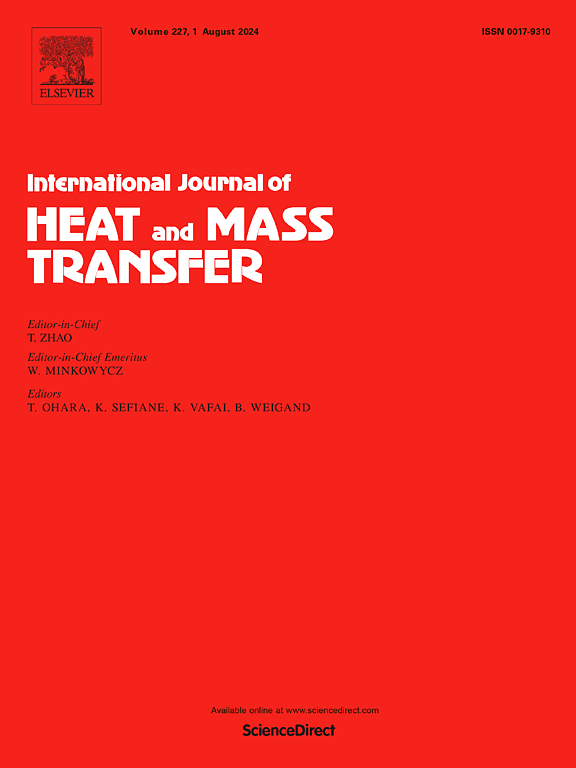Impact of working fluid properties on heat transfer and flow characteristics of two-phase loop thermosyphon with high filling ratios
IF 5
2区 工程技术
Q1 ENGINEERING, MECHANICAL
International Journal of Heat and Mass Transfer
Pub Date : 2024-11-26
DOI:10.1016/j.ijheatmasstransfer.2024.126482
引用次数: 0
Abstract
The two-phase loop thermosyphon (TPLT), known for its excellent heat transfer performance, simple and compact structure, and lack of need for a pump, effectively addresses heat transfer challenges in confined spaces under high heat loads.
Compared to TPLT with low filling ratio, high-filling-ratio TPLT not only exhibit a higher maximum heat transfer capacity but also has a more complex heat and mass transfer process, leading to increased sensitivity to the working fluid's properties. Therefore, studying the impact of the working fluid on the operational state of high-filling-ratio TPLTs is crucial for understanding their heat transfer mechanisms. In this paper, comprehensive experiments were conducted on TPLT filled with H2O and R134a as working fluids in a wide filling ratio range (30 % -90 %), and their heat transfer performance and flow characteristics were compared. Heat transfer diagram, two-phase flow pattern diagram, and the distribution of gas-liquid two-phase of the TPLT was established with different filling ratio and heat input. Due to differences in latent heat of vaporization, the maximum heat transfer capacity of the H2O-TPLT (390 W/cm2) is greater than that of the R134a-TPLT (270 W/cm2). In the H2O-TPLT, the predominant large-volume slug flow leads to significant flow resistance. Whereas in the R134a-TPLT, the flow pattern is primarily dominated by small-volume bubbly flow and churn flow, resulting in low resistance. High viscosity and flow pattern in the H2O-TPLT cause oscillation phenomena, leading to significant temperature and pressure fluctuations. Under high filling ratio, both types of TPLT experiences geyser boiling phenomena causing periodic temperature and pressure fluctuations and flow pattern changes. In summary, R134a is the preferred working fluid when heat transfer requirements are met, as it effectively reduces temperature fluctuations while dissipating heat. When exceeding the R134a-TPLT's maximum heat transfer capacity and less stringent temperature control is acceptable, H2O may serve as the working fluid.
工作流体特性对高填充比两相循环热流器传热和流动特性的影响
两相环热泵(TPLT)以其优异的传热性能、简单紧凑的结构和无需泵而著称,可有效解决高热负荷下密闭空间的传热难题。与低填充率 TPLT 相比,高填充率 TPLT 不仅具有更高的最大传热能力,而且传热传质过程更加复杂,导致其对工作流体特性的敏感性增加。因此,研究工作流体对高填充比 TPLT 运行状态的影响对于了解其传热机理至关重要。本文对填充 H2O 和 R134a 作为工作流体的 TPLT 在较宽填充率范围(30 % -90 %)内进行了综合实验,并比较了它们的传热性能和流动特性。绘制了不同填充率和输入热量时 TPLT 的传热图、两相流模式图和气液两相分布图。由于汽化潜热不同,H2O-TPLT 的最大传热能力(390 W/cm2)大于 R134a-TPLT 的最大传热能力(270 W/cm2)。在 H2O-TPLT 中,主要的大容积蛞蝓流导致显著的流动阻力。而在 R134a-TPLT 中,流动模式主要是小体积气泡流和搅动流,因此阻力较小。H2O-TPLT 中的高粘度和流动模式会引起振荡现象,从而导致显著的温度和压力波动。在高填充率条件下,两种 TPLT 都会出现间歇泉沸腾现象,导致周期性的温度和压力波动以及流动模式变化。总之,在满足传热要求的情况下,R134a 是首选的工作流体,因为它能在散热的同时有效降低温度波动。如果超过了 R134a-TPLT 的最大传热能力,并且可以接受不太严格的温度控制,则可以使用 H2O 作为工作流体。
本文章由计算机程序翻译,如有差异,请以英文原文为准。
求助全文
约1分钟内获得全文
求助全文
来源期刊
CiteScore
10.30
自引率
13.50%
发文量
1319
审稿时长
41 days
期刊介绍:
International Journal of Heat and Mass Transfer is the vehicle for the exchange of basic ideas in heat and mass transfer between research workers and engineers throughout the world. It focuses on both analytical and experimental research, with an emphasis on contributions which increase the basic understanding of transfer processes and their application to engineering problems.
Topics include:
-New methods of measuring and/or correlating transport-property data
-Energy engineering
-Environmental applications of heat and/or mass transfer

 求助内容:
求助内容: 应助结果提醒方式:
应助结果提醒方式:


